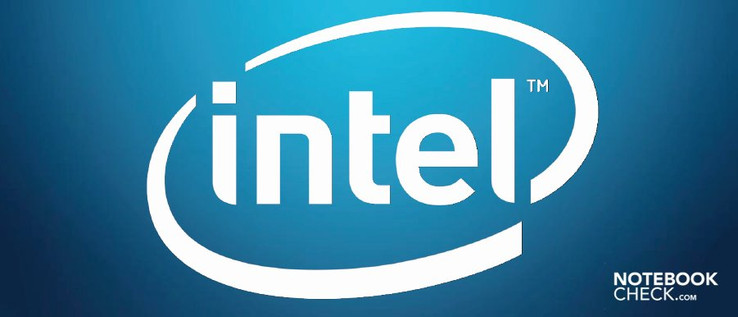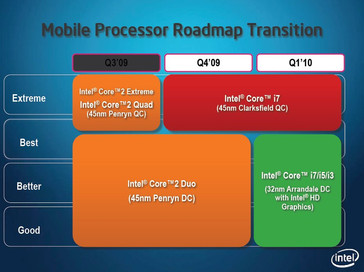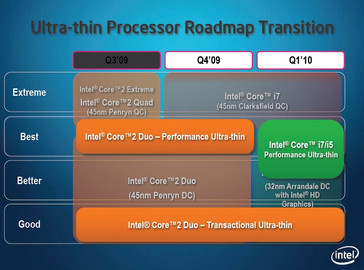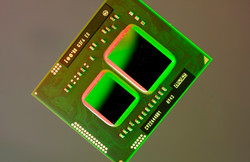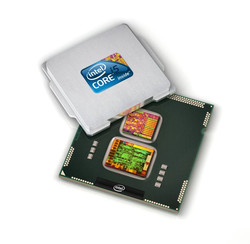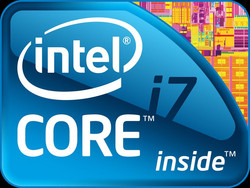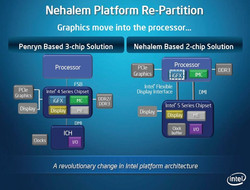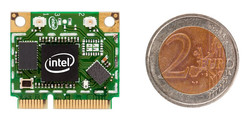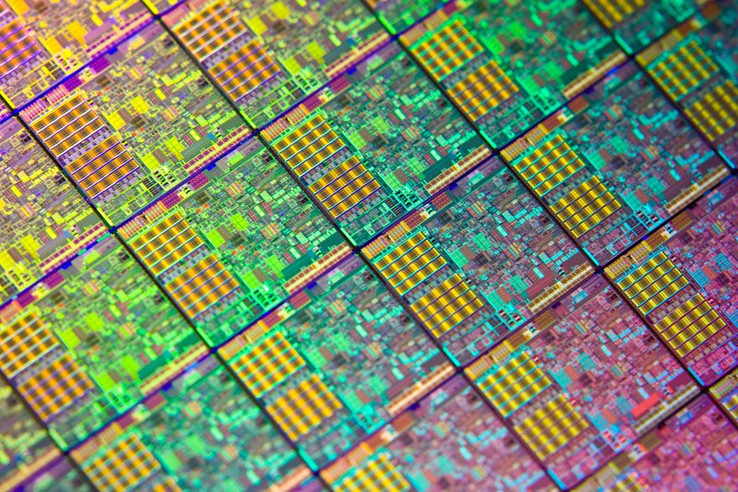NBC on site: Intel presents new processor line-up
by Florian Wimmer 01.04.2010
A new family
Already in December Intel invited us to a press conference in Munich and revealed confidential details of their new processor line-up of the beginning of 2010. Besides new CPU's Intel also introduces new chipsets, integrated graphics processors and wireless solutions. We were on site and outline the most important facts about the innovations soon to be launched in this article.
Intel is going present their new processors and chipsets in public at the CES on 7th of January. We can already quote most facts now. In the next days an extensive comparison test of the new Intel mobile Core i5 CPU line-up will follow here on notebookcheck.net.
Intel's "Core-i"-family is already well known in desktop computers. Last year some of Intel's i7 CPUs based on the Clarksfield architecture were already used in some notebooks and raised the bar for mobile processor performance quite a bit. This year Intel wants to integrate all powerful processors in the "Core i" family, and the Core 2 Duo family is phased out. The Mobile Pentium and Celeron processors will be continued. The same is true for the ULV-model of the Core 2 Duo.
For now the Core i7 processors based on Clarksfield with a 45 nm lithography remain the best. Only processors based on the Arrandale platform, which are made in 32 nanometer process and only have two physical cores are going to be introduced. Because of the finer process Intel could decrease the energy demand: The TDP (Thermal design power) of the Arrandale CPUs is at most 35 Watt. In comparison the Clarksfield processors require 45 Watt. Furthermore Intel can place more transistors on the chip: 383 million fit on the 81 mm² die. However, the memory controller and the graphics chip which are also integrated on the same die are still processed in 45 nm.
The integrated graphics chip "Intel HD Graphics" of the Arrandale platform is no longer integrated in the chipset but directly on the processor. As an advantage, Intel can now also apply its Turbo-Boost-technology to the graphics chip: Now, not only the clock speed of each core can be increased, but also the clock of the graphics chip. However, it is not possible to simultaneously speed up cores and graphics chip.
The new Core i3
In the future the "Core i" is divided in three series: In the desktop as well as in the mobile field the Core i3 series is completely new. It should cover the entry-level models of the "Core-i" family in future. These do not feature Intel's Turbo Boost technology, which allows the processor to autonomously switch between single and higher clocked cores or more and lower clocked cores.
In the beginning Intel will offer two models: The Intel Core i3-350M with 2.26 GHz clock and the Core i3-330M with 2.13 GHz. Both models feature 3 MB Cache and support DDR3 memory up to a clock of 1066 MHz. The prices of the Core i3 processors were not known at the time of writing.
Known from desktops: The Core i5
The Core i5 series is already known in desktop computers. If anything, these processors can be considered successors of the Core 2 Duo series. In addition the Core i5 models based on the Arrandale platform feature the well-known Hyper-Threading and Turbo-Boost technologies. The later can, as already mentioned above, also be used for the integrated graphics chip.
According to Intel Core i5 models of the same price should achieve up to 34% more points in the PCMark Vantage. Intel presents four models of the mobile Core i5, among others a ultra-low-voltage CPU: The core i5-520UM has a base clock of 1.06 GHz, which can be raised to 1.86 GHz, 3MB Cache and a TDP of 18 Watt.
It's a striking fact that ULV Core 2 Duo processors with similar clock rates had a TDP of only 12 Watt. However, you have to consider that the graphics chip is already integrated in the Core i5 processors and does need additional energy in systems with Core 2 Duo processor. A manufacturer has to pay 241 US-dollars for 1000 units of the processor. That's about the impact a single processor used to have on the price of a notebook.
The most powerful mobile Core i5 processor is the Core i5-540M with 2.53 GHz base clock, 3.06 GHz maximum clock, and 3 MB Cache. It's official price for 1000 units is 257 dollars.
Everything new in 32nm? The Core i7
Basically, the five new Core i7-models in 32-nanometer lithography are not high-performance processors. This remains the privilege of i7 CPUs made in 45nm. On the contrary, most of the new chips are designed for energy-saving notebooks. Contrary, to the hitherto existing Core i7-models all new ones feature only two physical cores and can so handle up to four threads at the same time by means of multi-threading.
Intel's line-up consists of two ultra low voltage Core i7 models with a TDP of only 18 Watt: The Core i7 620 UM is basically clocked at 1.06 GHz and can reach up to 2.13 GHz with the turbo function. The Core i7 640 UM clocks from 1.20 to 2.26 GHz. Different to the Core i5-models they sport 4 MByte Cache and support only DDR3-RAM with a maximum clock speed of 800 MHz. The price is about 278$ for thousand 620 UM processors respectively 305$ for thousand units of the 640 UM.
Above them Intel positions two Core i7-processors with a TDP of 25 Watt, which should perform better: The 620 LM has a base clock of 2.0 GHz and can speed up to a maximum of 2.8 GHz. Thousand units of this processor cost 300$. The higher clocked 640 LM is 32$ more. Its clock ranges from 2.13 GHz to a maximum of 2.93 GHz. Both support only up to 1066 MHz DDR3-RAM.
The most powerful 32 nanometer-Core i7 is the 620M with a base clock of 2.66 GHz and a maximum of 3.33 GHz. For this it needs a TDP of 35 Watt. Alike the 640 LM, the 620 M costs 332$ per thousand units. The 620M also supports DDR3-RAM up to 1066 MHz.
The new Core i7 models complement the ULV models of the Core 2 Duo and replace the fastest Core 2 Duo CPUs. Although Intel intended to simplify the naming, it remained as confusing as previously: On the one hand a "6" in the name indicates that only two cores are available. On the other hand only a single letter specifies whether it is a low voltage, ultra low voltage or standard voltage processor, i.e., a "U" or a "L" in the name, while identical numbers are used. While it might be plausible from Intel's internal point of view that apparently one and the same processor is driven by a different voltage, this can be quite confusing for customers.
The new chipsets
For the most part new processors also require new chipsets. The fifth chipset by Intel includes many important changes: Except for the graphics chip being integrated into the processor chip, another component was completely omitted: The I/O controller formerly implemented as Southbridge is now directly integrated in the chipset. Furthermore, the processor communicates directly with the PCIExpress-interface and, so, also with a dedicated graphics card or the DDR3-RAM.
Intel offers four different chipsets: They range from the HM 55-chipset at 40$ for undemanding computing up to the luxury QS 57 chipset at 53$. The chipsets support a maximum of 14 USB ports, 6 eSATA ports, 8 PCIe interfaces for internal components and 4 standard PCI ports. While the QM and the QS 57 feature remote support and other features and mainly focus on professional users, the smallest chipset, the HM55, sports less interfaces than its bigger brothers. Intels new chipset generation does still not support USB 3.0 in a native form, because Intel did not feel that the new standards found much acceptance so far.
Intel's new HD graphics chips integrated in the processor package, the Intel HD Graphics or GMA HD supports Blu-ray-decoding of two video streams and can disburden the processor that way. Furthermore, the clock rate of the graphics unit was increased too (500 or 700 MHz depending on the CPU) and OpenGL2.1 is supported. But, the chips do still not support DirectX11, which was introduced with Windows 7. Regarding audio Intel now supports Dolby TrueHD and DTS HD Master Audio; important features for all Blu-ray fans and hitherto unrivaled for notebooks (the coming Mobility Radeon HD 5000 series is said to support it, too).
Centrino comes back
New wireless network modules are now also available from Intel. As from now they are no longer called "WiFi Link", but "Centrino". Therewith the name of the chipset with which Intel extensively brought WLAN to mobile computers is rediscovered.
The Californians present three new WLAN-cards: The Centrino Standard-N 1000 allows a maximum transfer speed of 150 Megabit per second via one antenna and two data streams. This should easily suffice current home networds and DSL 6000. Whoever wants more power and more signal stability should look for notebooks with Centrino Advanced-N 6200, which features two antennas and a transfer speed up to 300 Megabit per second. The high-end solution is offered by the Ultimate-N 6300 with 3 antennas and 3 data streams. Therewith it can reach up to 450 Megabit per second.
As already the name of the cards implies, they all support the new wireless-standard 802.11n.
A verdict to Intel's new line-up
Basically Intel also wanted arrange for processor names more transparent to the consumers. We doubt whether they were finally successful: There are Core i7 processors with four cores in 45 nm lithography, Core i7 processors with 2 cores in 32 nm lithography and with integrated graphics card, and ULV-core i7 processors and ULV core i5 processors which do not differ much in terms of performance. Furthermore, there are also Core i3, Pentium, and Celeron processors - and here also Intel's marketing people had difficulties to explain the differences.
It would have been more transparent if they had, e.g., grouped all ULV-processors by a single name and if the Core i7 series would consist only of quad-cores CPUs. This had also strengthened the profile of the i5 series as dual-core successor of the Core 2 Duo. The Core i3 series, a low-end processors without hyper-threading and turbo-boost is reasonably clearly defined. At least even a non-expert buyer can now tell by a number (3,5, or 7) in which performance league its processor plays.
Furthermore, Intel also offers its latest technologies, e.g., the turbo boost, which is quite reasonable in the mobile field, with the Core i5 series also in the affordable mainstream area. However, the first test samples will have to prove how much performance or energy-saving the turbo boost of the integrated graphics chip actually brings.
On the pro side Intel now allows to switch to a dedicated graphics card during use right from the start. Furthermore, multimedia fans will be pleased by the native blu-ray decoding of the graphics chip, which unburdens weak processors. The new wireless cards aren't a quantum leap, but a sensible enhancements and bring back a name which can be easily remembered.
Overall, Intel focuses on the market of small and light laptops with its new processors, because they expect the biggest growth there. This is also proved by the big number of ULV processors in the powerful 32-nm Core i7 series.
Occasional gamers who play World of Warcraft at best, will be satisfied. But, gaming enthusiasts or graphic professionals will stick to the Core i7 in 45nm. At least until Intel introduces its 32-nm six-core processor code-named Gulftown. It's said to be launched in 2010. May we probably test a Core i9 soon?




